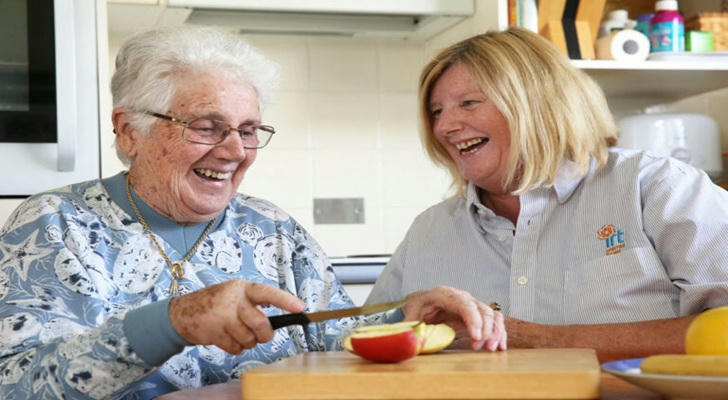The Trend of Local Home Care Services That Americans Are Looking For in 2025
For millions of American adults, the challenge of balancing work, children, and the needs of aging parents has defined a new era of caregiving stress. Dubbed the “sandwich generation”, these individuals are navigating a stage of life where responsibilities pile high — and time, energy, and resources feel constantly stretched.

But in 2025, one powerful shift is helping families breathe easier: the rapid rise of local home care services that are not only accessible, but also personalized, tech-integrated, and compassionate.
“I used to feel like I had to do it all — run errands, manage my dad’s medications, cook, clean, keep him company,” says Melissa, 52, from Pennsylvania. “Then I found a local senior care team. Now, I can just be his daughter again.”
Let’s explore this growing trend, the services available, how they’re transforming elder care in America, and what families should know when seeking the right kind of help.
1. Why the Shift? Demographics and Demand
According to the U.S. Census Bureau, by 2030, one in five Americans will be over the age of 65, with a significant percentage living well into their 80s and 90s. At the same time, family sizes are smaller, adult children are more geographically spread out, and many are working full-time or raising kids themselves.
In 2025, the need for non-institutional, local caregiving options has reached a tipping point.
Key drivers include:
- A desire for aging in place (most seniors prefer staying at home)
- Shortages and costs in nursing home and assisted living spaces
- Advances in home-monitoring and health tech
- Changing attitudes: Seeking support is now seen as smart, not selfish
"We don’t have to do it alone anymore — and we shouldn’t," says AARP caregiving expert Julia Kamen.
2. What Do Modern Local Home Care Services Include?
Forget the outdated image of someone coming in just to make a meal. Today’s home care is comprehensive and customizable, designed to match both the needs of the elderly and the preferences of their families.
Here’s what’s commonly offered:
✅ Personal Care:
- Bathing, dressing, toileting
- Mobility assistance (transfers, fall prevention)
- Medication reminders and tracking
✅ Household Support:
- Cooking and meal prep (including dietary restrictions)
- Light housekeeping and laundry
- Grocery shopping and errand running
✅ Companionship:
- Conversation and social engagement
- Accompanying to appointments or community events
- Cognitive stimulation (puzzles, games, memory care)
✅ Specialized Support:
- Dementia and Alzheimer’s trained aides
- End-of-life palliative assistance
- Respite care (temporary relief for family caregivers)
Some providers also offer telehealth coordination, regular digital updates for family members, and integration with smart home tools such as medication dispensers and fall-alert systems.
3. The Emergence of Micro-Local and Boutique Care Agencies

One of the most exciting trends in 2025 is the micro-localization of home care. Rather than large national chains, families are seeking smaller, community-rooted agencies that prioritize relationships and cultural understanding.
Benefits of boutique or local-first home care providers:
- Faster response times
- More personalized care plans
- Better staff retention (less turnover = continuity of care)
- Cultural/linguistic alignment with local families
- Community reputation you can verify through neighbors or local forums
"Our caregiver grew up just a few streets over from my mom," shares James, a 59-year-old from Atlanta. "She knows our neighborhood, the church, even the grocery store staff. That kind of connection matters."
4. The Cost of Care: What to Expect in 2025
Finances remain a major concern. While home care is often more affordable than institutional care, costs vary widely based on region, level of care, and frequency.
Average Costs (2025 Estimates):
| Service Type | Average Hourly Rate | Monthly Estimate (20 hrs/week) |
|---|---|---|
| Personal/Home Care Aide | $28–$35 | $2,240–$2,800 |
| Companion Care Only | $25–$30 | $2,000–$2,400 |
| Specialized Dementia Care | $35–$45 | $2,800–$3,600+ |
| Live-In 24-Hour Care | $250–$350/day | $7,500–$10,500 |
Ways Families Are Managing Costs:
- Long-term care insurance policies
- Medicaid waivers (especially for low-income seniors)
- Veteran’s Aid & Attendance Benefits
- Tax deductions for dependent care
- Shared caregiving among siblings or friends
Many agencies now offer flexible packages, trial periods, and sliding scale options based on need — so it’s worth shopping around and asking directly.
5. Technology Makes Home Care Smarter (and Safer)
In 2025, care is no longer limited to face-to-face visits. Smart tech integration now supports seniors and their families in ways unimaginable a decade ago:
- Wearable emergency buttons that auto-alert caregivers
- Fall detection sensors in floors or bed frames
- Digital caregiver logs and family apps for real-time updates
- Remote medication dispensers with alerts for missed doses
- Voice assistants programmed for medication reminders and companionship
Some agencies offer tech-onboarding services, setting up devices and training both seniors and their families on how to use them effectively.
“I live in Denver, my mom’s in Santa Fe, but I get updates every day on her care — meals, meds, even mood,” says Rachel, 47. “It gives me peace of mind I never thought possible.”
6. Questions to Ask Before Choosing a Provider
Not all home care services are equal. Here’s a checklist of essential questions to ask when interviewing agencies or individual caregivers:
- Are your caregivers licensed, trained, and background-checked?
- Do you specialize in any conditions (e.g., dementia, mobility issues)?
- How do you match clients with caregivers?
- Is your agency insured and bonded?
- Can we interview or meet the caregiver before starting?
- What happens in case of a caregiver emergency or illness?
- How are daily reports or updates provided?
- Are there flexible options or trial periods?
Request references from other families, and don’t be afraid to start with a short-term engagement before committing.
7. A Culture Shift: Caregiving Is Not a Burden — It’s a Collaboration

Perhaps the most heartening change in 2025 is not technological or logistical — but emotional. More families are embracing the idea that caregiving doesn’t mean doing it all yourself.
Support services are now seen as a gift, not a failure. Home care allows adult children to focus on quality time with their parents, rather than logistical stress.
“The best part of hiring a caregiver?” says Tom, 58, in Minnesota. “Now, when I visit Mom, we watch old movies together. I don’t spend the whole visit scrubbing her kitchen.”
Conclusion: Taking Care, the Smart Way
In 2025, taking care of your parents no longer means sacrificing your career, your health, or your peace of mind.
Thanks to local home care services, compassionate aides, and smart technology, American families now have more tools than ever to ensure their aging loved ones are safe, dignified, and truly cared for — at home.
Whether your loved one needs a few hours of companionship a week or daily hands-on care, there is a solution that fits your budget, lifestyle, and values.
Because caregiving doesn’t have to be about exhaustion. It can be about love — with support.
?
